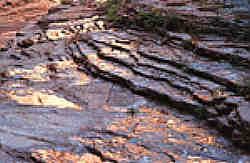Bacterium May Reveal Location of Gold Deposits

© public.asa.edu
Gold prospectors may one day rely on lowly bacteria to point them to deposits of the precious metal. Researchers have discovered that gold-laden soil often contains an abundance of spores belonging to a certain bacterium. The affinity humans have for gold aside, the ore in its soluble form is actually highly toxic to most living things. The common bacterium Bacillus cereus, however, possesses a unique resistance to the metal, allowing it to survive in a relatively vacant environmental niche: soil loaded with the adored ore. A paper presented yesterday at a meeting of the American Society for Microbiology documents these rich findings.
It was while studying gold-mining regions in China that Hongmei Wang of Ohio State University and her colleagues discovered that high numbers of B. cereus spores occur in soils bearing elevated concentrations of gold, as compared to soils lacking gold. The key is the spore: a bacterial spore, or tough shell, forms in response to harsh environmental conditions like heat, cold, radiation, or the presence of toxic substances such as gold. Spores allow bacteria to survive until more favorable conditions develop and the bacteria can resume their normal growth. Because high gold levels induce spore formation in B. cereus, an abundance of B. cereus spores in soil can indicate the presence of gold, which is good news for mining companies.
Testing B. cereus levels is cheaper and more efficient than the painstaking techniques currently used to search for gold. “This biotechnique will help exploration and mining companies search for underlying gold deposits with relatively high gold grades,” Wang remarks. “The method is, therefore, promising for the potential application in geoexploration accompanied with routine geochemical and geophysical methods.”
Media Contact
All latest news from the category: Earth Sciences
Earth Sciences (also referred to as Geosciences), which deals with basic issues surrounding our planet, plays a vital role in the area of energy and raw materials supply.
Earth Sciences comprises subjects such as geology, geography, geological informatics, paleontology, mineralogy, petrography, crystallography, geophysics, geodesy, glaciology, cartography, photogrammetry, meteorology and seismology, early-warning systems, earthquake research and polar research.
Newest articles

Self-Destructing Cancer Cells: Cutting-Edge RNA Breakthrough
Jülich scientists use novel RNA technology to selectively switch off tumours in the brain. An Adaptable Platform Technology That Destroys Glioblastoma Cancer Cells Using a special RNA molecule, a team…

Endurance Training: Transforming Lives of Heart Failure Patients
Can strength and endurance training be beneficial for patients with a certain form of heart failure? A research team from Greifswald investigated this question together with seven other research centers…

A Wake-Up Call for Mediterranean Shark Protection Against Extinction
Overfishing, illegal fishing and increasing marketing of shark meat pose significant threats to the more than 80 species of sharks and rays that inhabit the Mediterranean Sea, according to a…



